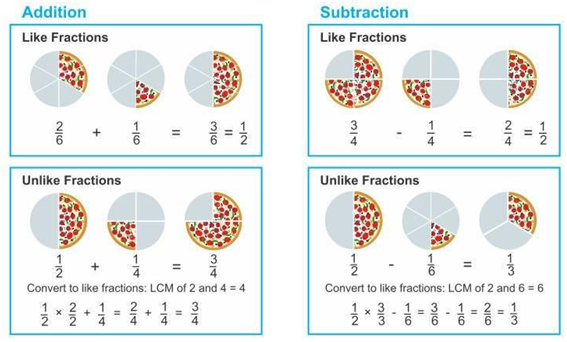CLASS-6
LIKE FRACTION & UNLIKE FRACTION
LIKE FRACTION & UNLIKE FRACTION -
Like Fractions:- Like fractions are fractions that have the same denominator. For example, 1/4, 3/4, and 5/4 are like fractions because they all have the same denominator (4).
To add or subtract like fractions, you only need to perform the operation on the numerators while keeping the common denominator unchanged.
Example.1) Adding like fractions 1/4 + 3/4 = (1 + 3)/4 = 4/4 = 1
Example.2) Subtracting like fractions 5/6 - 2/6 = (5 - 2)/6 = 3/6 = 1/2 (Note:- You can simplify the result to 1/2 by dividing both the numerator and denominator by their greatest common divisor, which is 3 in this case.)
- 2/5 and 3/5 are like fractions because they both have the same denominator, which is 5.
- 1/8 and 5/8 are also like fractions because they share the same denominator, which is 8.

Unlike Fractions:- Unlike fractions are fractions that have different denominators. For example, 1/3 and 2/5 are unlike fractions because they have different denominators (3 and 5, respectively).
To add or subtract unlike fractions, you first need to find a common denominator for all the fractions and then perform the operation on the numerators.
Example.1) Adding unlike fractions 1/3 + 2/5 = (1 * 5)/(3 * 5) + (2 * 3)/(5 * 3) = 5/15 + 6/15 = 11/15
Example.2) Subtracting unlike fractions 3/8 - 1/6 = (3 * 6)/(8 * 6) - (1 * 8)/(6 * 8) = 18/48 - 8/48 = 10/48 (Note: You can simplify the result to 5/24 by dividing both the numerator and denominator by their greatest common divisor, which is 2 in this case.)
- 2/3 and 1/4 are unlike fractions because they have different denominators (3 and 4).
- 5/6 and 2/9 are also unlike fractions as their denominators are different (6 and 9).
In summary, like fractions have the same denominators, and you can directly perform operations on the numerators. Unlike fractions have different denominators, so you need to find a common denominator before performing any addition or subtraction.
When working with like fractions, operations like addition, subtraction, multiplication, and division become easier because you can directly operate on the numerators while keeping the common denominator unchanged. On the other hand, when dealing with unlike fractions, you often need to find a common denominator to perform these operations effectively.